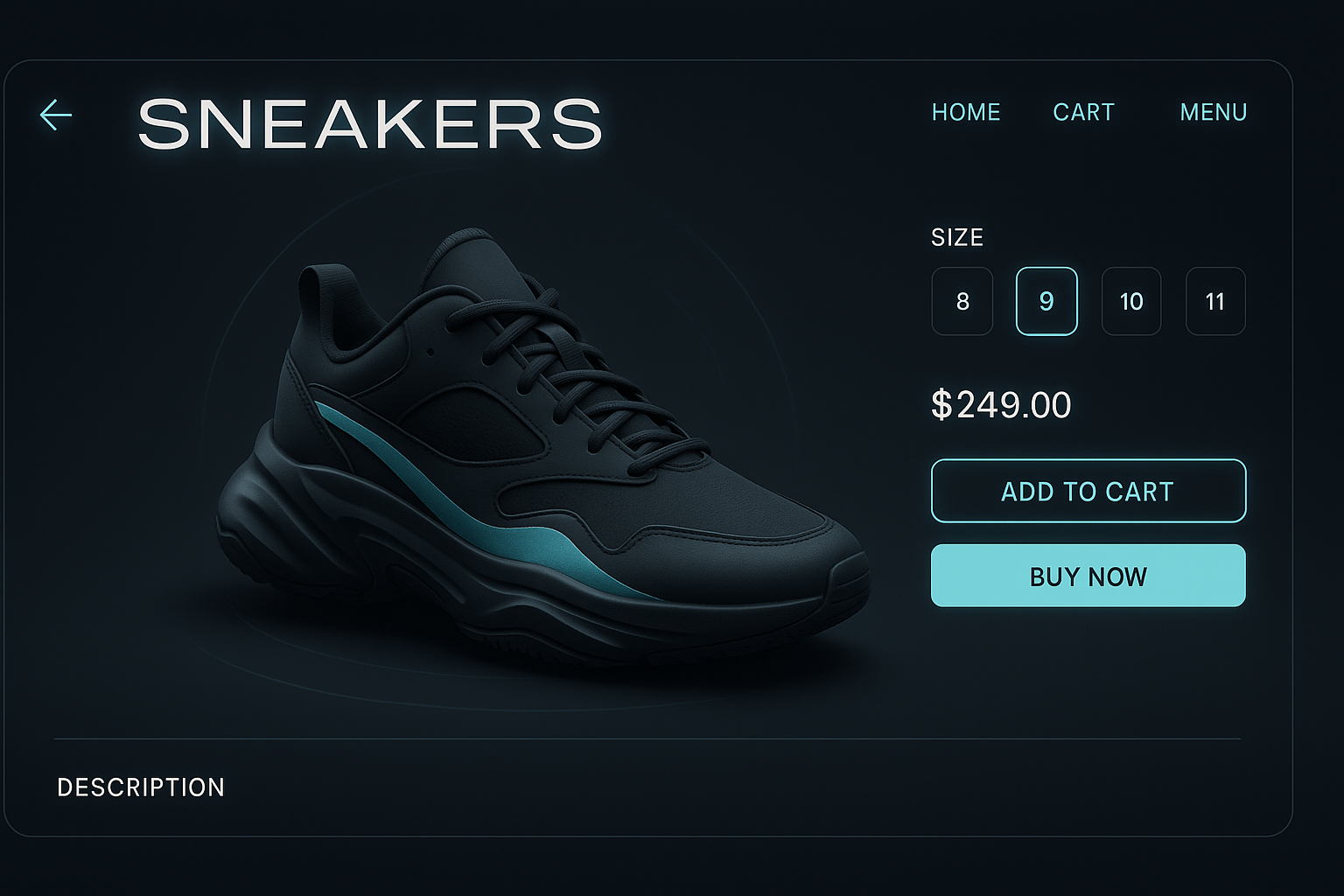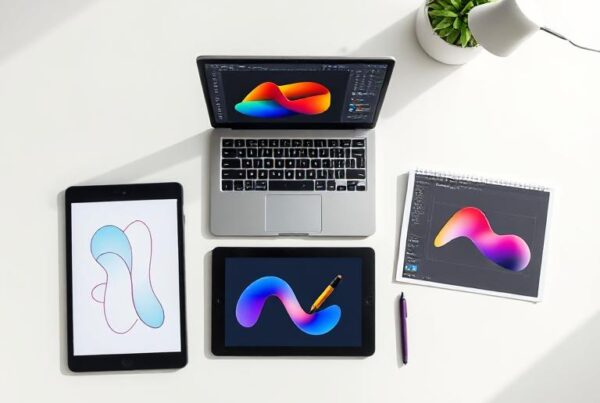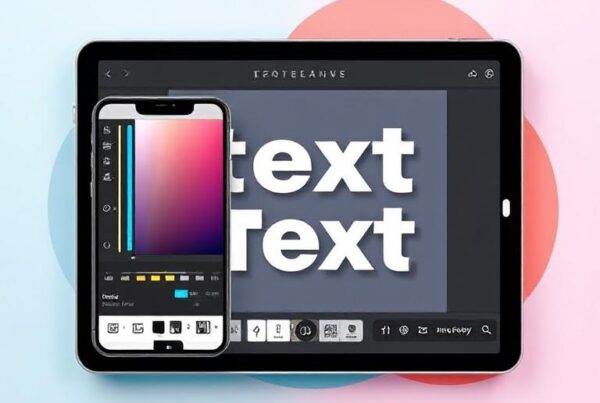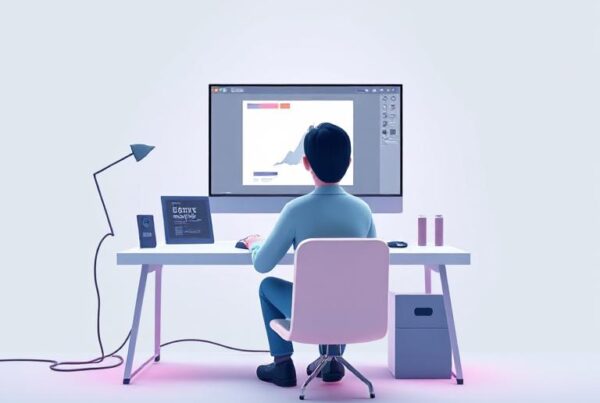3D product animation for e-commerce is revolutionizing online shopping, with top brands seeing up to 250% more conversions when implementing this technology. Unlike static images, 3D animations bring your products to Life with realistic movement and detail, creating a more engaging shopping experience for your customers.
When your customers can interact with virtual versions of your products while shopping online, they’re 100% more likely to trust what you’re selling. This enhanced interaction leads directly to higher satisfaction and conversion rates, positively impacting your bottom line. Additionally, 3D product animation for e-commerce provides an immersive shopping experience, allowing customers to explore every detail of your offerings online. Online retailers consistently report higher sales figures after adding 3D product images to their stores.
The integration of 3D rendering has fundamentally transformed how products are showcased and sold in the digital marketplace. As we move into 2025, animated product videos for online stores aren’t just a luxury feature – they’re becoming essential for e-commerce businesses that want to stay competitive. Throughout this article, you’ll discover how leading brands are implementing this technology, the specific platforms and tools they’re using, and how you can achieve similar results for your online store.
Real ROI: How 3D Product Animation Boosts Sales on Shopify & Amazon
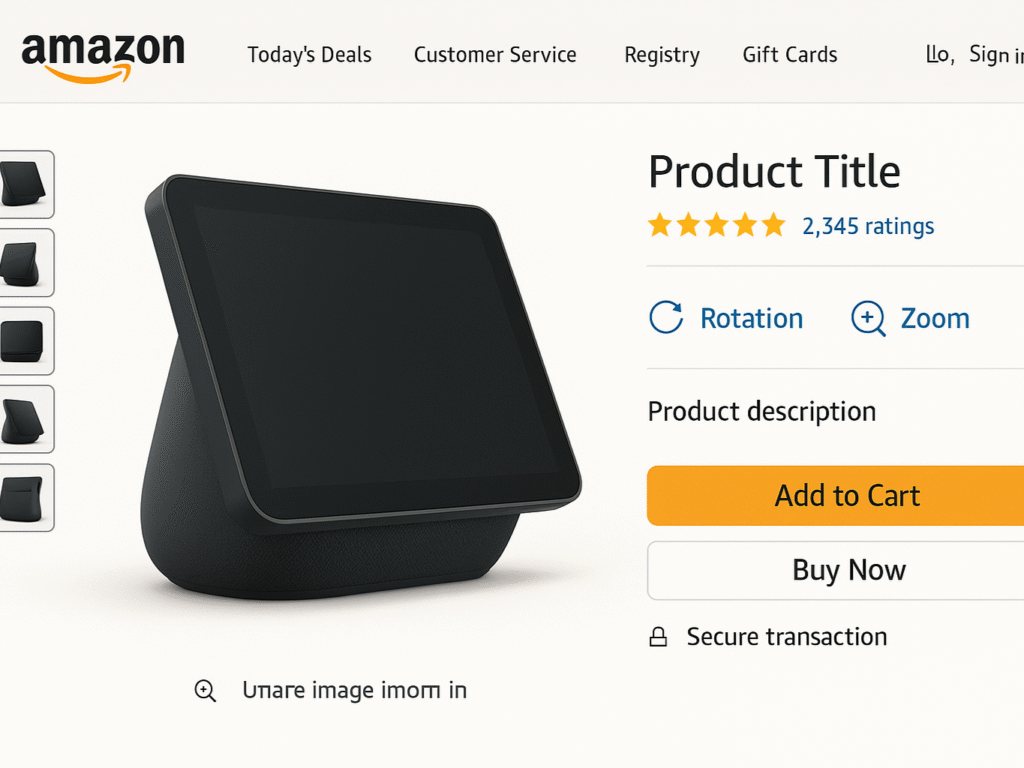
The numbers don’t lie: brands implementing 3D product animation for e-commerce are seeing remarkable results across major e-commerce platforms. Let’s examine real case studies that showcase how this technology delivers tangible business outcomes.
1. Shopify brand Case Study: Rebecca Minkoff’s 3D Revolution: A 180% Surge in Conversions
Rebecca Minkoff, a trailblazer in fashion and digital innovation, showcased how immersive shopping can redefine e-commerce. By integrating 3D product animation for e-commerce and augmented reality directly into their Shopify product pages, they not only enhanced UX but also triggered measurable growth in customer engagement, satisfaction, and conversions.
(i) The Problem: Bridging the Gap Between Digital and Physical Retail
Rebecca Minkoff’s challenge was simple but significant: replicate the tactile, luxurious feel of their physical stores in a digital environment. As a fashion-forward brand, every texture and silhouette mattered, yet traditional images fell short.
- Flat photography failed to capture movement and depth.
- Return rates were increasing due to unmet expectations.
- Shoppers felt less emotionally connected online.
To solve this, they turned to interactive 3D and AR tech, allowing shoppers to view every angle, zoom into fabrics, and imagine products in real-life settings.
- Customers could rotate handbags 360 degrees.
- They could explore stitching and size in detail.
- AR allowed them to “place” products in their space.
The switch didn’t just enhance user experience; it redefined it. Shoppers lingered longer, explored deeper, and engaged more emotionally with the products.
- Time-on-page jumped by over 70%.
- Bounce rate on product pages dropped significantly.
- Product return requests declined steadily.
This rich visual storytelling triggered a psychological shift. Customers went from passive browsing to confident decision-making, a key milestone that drives conversions.
(ii) The Impact: From Browsing to Buying With Confidence
Rebecca Minkoff saw measurable results after implementing 3D product animation for e-commerce. Visitors who interacted with 3D content were 44% more likely to add items to their cart, a direct lift in engagement.
In the next step of the buyer journey, shoppers who viewed AR content became 65% more likely to place an order. This leap showcased how immersion closes the gap between inspiration and conversion.
- 27% more shoppers completed checkout after 3D engagement.
- Mobile interactions surged, especially on product pages with AR.
- Conversion rates overall climbed 180%, an industry-breaking result.
Rebecca Minkoff didn’t just adopt a trend; they led a transformation by partnering with specialized 3D product animation services that understood the requirements of luxury fashion. Their brand loyalty improved, reviews got more detailed, and their digital store became an extension of their luxury brand ethos.
(iii) The Technology: How They Integrated 3D Into Shopify
Implementing 3D product animation for e-commerce on Shopify required strategic planning and the right tools. Rebecca Minkoff used services that offered realistic rendering, smooth load times, and mobile optimization.
Their development team built a product experience that didn’t interrupt the purchase journey; it enhanced it. The 3D content loaded quickly and was intuitive for shoppers to engage with, even on smartphones.
Their team selected a visualization partner with deep experience in fashion modeling. Every detail, from metallic zippers to leather grain, was represented with precision. It helped maintain the brand’s premium positioning even in a digital environment.
The Shopify platform made it possible to integrate AR through the product page without app downloads. This frictionless experience was key to adoption. Shoppers didn’t need to leave the page; they could interact instantly and return to purchase.
(iv) The Takeaway: Why 3D Product Animation Is the Future
The Rebecca Minkoff case proves that 3D product animation isn’t just a trend; it’s a conversion powerhouse. In today’s digital-first landscape, brands must build trust without touch. 3D visuals give shoppers that confidence.
- It reduces product returns by showing real detail.
- It increases dwell time and interaction rates.
- It boosts emotional connection with the product.
This technology answered modern shoppers’ needs while staying true to the brand’s luxurious DNA. It wasn’t gimmicky, it was strategic.
- Visual fidelity preserved brand aesthetics.
- Mobile-first execution met users where they shop.
- Seamless integration avoided friction in the buyer journey.
Brands aiming to future-proof their stores can learn from this case. Rebecca Minkoff’s success with 3D product animation for e-commerce demonstrates that immersive experiences not only delight but also deliver a measurable ROI.
3D Product Animation Services: Your Step-By-Step Buyer’s Guide [2025]: Ready to implement 3D animations like Rebecca Minkoff? Our comprehensive buyer’s guide reveals the exact steps, costs, and service providers that deliver 180% conversion increases. Get the insider knowledge that transforms browsers into buyers.
2. Emplicit’s Amazon 3D Report
Amazon listings featuring 3D models and AR saw dramatic improvements: 2× lift in conversions, 9% more sales, and 20% lower return rates compared to standard images, according to Emplicit’s 2024 analysis.
(i) Key Metrics and Benefits
Amazon introduced interactive 3D and AR content tools to improve product visualization. According to Emplicit, sellers using these tools experienced measurable gains across key KPIs. Shoppers spent more time on listings, engaged deeper, and felt more confident buying, all of which led to higher sales and lower product return rates.
- 2× more conversions with 3D features
- 9% sales growth using virtual product views
- 20% drop in return rates from animated listings
These outcomes are tied to shopper psychology. When customers can see scale, detail, and fit accurately, they trust what they’re buying. The clarity leads to fewer post-purchase regrets, saving sellers thousands in return-related logistics and strengthening overall product satisfaction scores on Amazon.
- Higher time-on-page metrics
- Decrease in negative reviews
- Boost in “add to cart” behavior.
Ultimately, listings with 3D product animation for e-commerce outperform standard image listings in every measurable way. With enhanced engagement and fewer returns, sellers not only protect margins but also boost brand trust. This visual approach helps bridge the gap between digital presentation and physical expectations, addressing a long-standing e-commerce pain point.
(ii) Why It Works: Immersive Viewing Experience
Static images don’t capture product realism. Interactive visuals, such as 3D models and AR, enable customers to explore details, build confidence, and reduce decision anxiety. This deeper engagement mimics in-store experiences, encouraging stronger emotional connections and driving higher-quality purchasing decisions.
Emplicit’s study proves that customers exposed to interactive content are more likely to complete purchases. They feel in control of the shopping process. Rather than relying on generic angles, they rotate and zoom into products, reducing assumptions and improving satisfaction after delivery.
- Builds trust through realism
- Reduces return rates fast
- Matches buyer expectations accurately
Emotional engagement matters. People buy when they can picture the item in their lives. 3D animation activates this visualization. When shoppers virtually interact with a product, especially through AR, it becomes “real” to them. That psychological connection is what turns browsers into buyers and reduces second-guessing after the purchase.
(iii) Actionable Takeaways for Amazon Sellers
Sellers using animated product videos for online stores have a clear edge. Their listings are more engaging, more trusted, and more likely to convert. On Amazon, where dozens of listings compete, richer visuals instantly stand out. Customers reward that with more purchases and fewer complaints.
Implementing 3D content isn’t just about aesthetics. It’s a performance strategy. Sellers gain higher CTRs, stronger seller feedback, and lower ACoS. Enhanced content also improves SEO within Amazon’s algorithm. The result? Better visibility, higher placement in search, and longer time spent on listings, all leading to revenue lift.
Emplicit’s findings show these advantages aren’t limited to fashion or furniture—any product with dimension, texture, or usability benefits from 3D animation. From electronics to tools, buyers want clarity. Sellers who meet that demand will continue winning market share while static listings get left behind.
(iv) What Amazon Sellers Should Do Now
Start by auditing listings for high return rates or poor conversions. Those are your top candidates for 3D upgrades. Then, work with e-commerce product visualization services that can model, animate, and integrate content that meets Amazon’s standards and loads quickly on mobile.
- Upload 3D models through Seller Central
- Use Amazon AR templates
- Prioritize mobile UX
Once added, test performance weekly. Monitor cart additions, bounce rates, and review sentiment. Most sellers see improvements within 30 days. Track conversion rates before and after adding animation, and adjust based on product type and customer interaction behavior. The lift is often immediate.
- Lower return processing costs
- Increase buyer satisfaction
- Improve organic ranking
With proven results and Amazon’s full support of 3D and AR, this tech is now a seller’s secret weapon. Animated product videos for online stores don’t just look better, they sell better. If your competition has already adopted it, you’re behind. If they haven’t, you have the lead. Use it.
3. Why animated product videos for online stores outperform static images
The gap between static photos and 3D product animations is widening fast. Shoppers spend 44% more time on interactive 3D visuals. Videos can increase buying likelihood by 85%, keeping visitors engaged for longer and allowing products more time to make a positive impression.
According to the Content Marketing Institute, 3D animations increase conversions by up to 20%. Interactive ads featuring 3D elements boast a 94% higher click-through rate, proving that deeper visual engagement leads to better comprehension and stronger purchase intent.
3D animations address core e-commerce issues, providing full product views, fostering trust, and enhancing emotional engagement. One tech brand saw a 50% rise in click-throughs after using 3D product animations. These aren’t minor upgrades; they’re reshaping digital shopping into an immersive experience.
Integration Guide: Adding 3D Animation to Your Shopify Product Page
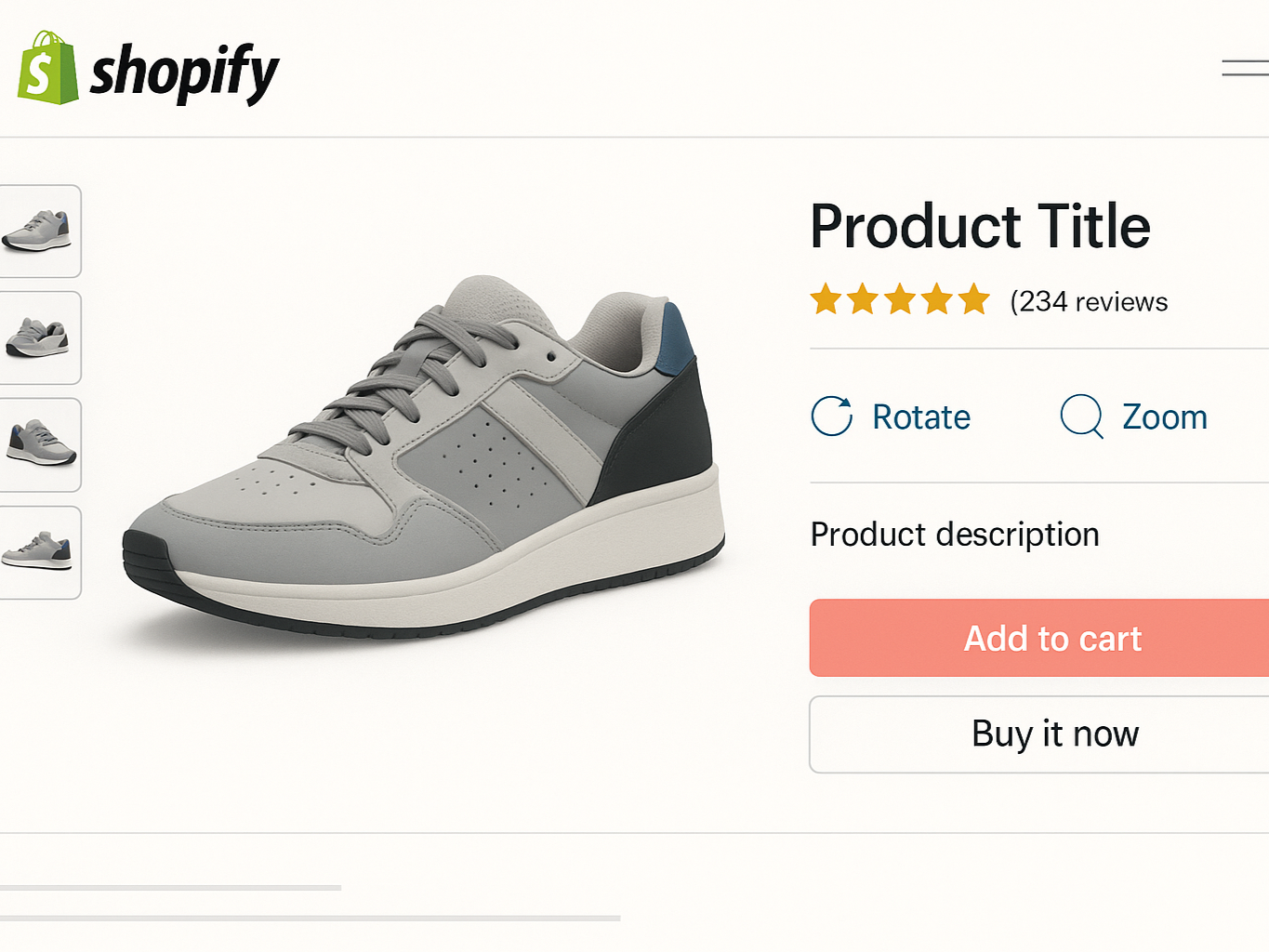
Getting your 3D animation Shopify product page up and running doesn’t require advanced technical expertise. With today’s tools, you can implement interactive 3D elements that engage customers and boost conversions with minimal hassle.
1. Using Shopify’s Native 3D Support
Shopify offers a built-in framework for adding 3D assets to your 3D animation Shopify product page without complex coding. This native approach ensures your content works seamlessly across both iOS and Android devices. To implement:
- Choose a compatible Shopify theme (Dawn, Empire, Responsive, or other updated themes)
- Prepare your 3D model in .glb or .usdz format (each under 500MB)
- Navigate to Products in your Shopify dashboard
- Select the product you want to enhance
- Upload your 3D model by dragging it into the media box
- Save changes and test the experience
2. VNTANA Integration
For brands needing pro-level visuals, VNTANA makes it easy to add 3D animation to your Shopify product page—fast integration, high performance, and improved customer experience all in one.
- Install the VNTANA app from Shopify’s App Store.
- Log in to your VNTANA account through the app interface
- Upload your 3D files to the VNTANA platform (supports files from Clo, Browzwear, Keyshot, Maya, etc.)
- VNTANA automatically optimizes and converts files to web-ready formats
- Link VNTANA assets to your Shopify products through the app
- Customize placement options:
a) Add a 3D button that opens a modal viewer
b) Embed the viewer directly into your product page
For modal implementation, ensure you enable the VNTANA Viewer Modal in App Embeds. Additionally, enabling VNTANA 3D Indexing improves Google search discoverability for your 3D products.
3. Recommended Tools and Plugins
Several specialized apps can help you create and integrate 3D animation into Shopify product page experiences:
(i) MazingXR, ARitize3D, and Loor3D
These Shopify-native apps offer full model creation and integration tools. Drag-and-drop interfaces make it easy to add immersive 3D and AR elements directly to your product pages without coding.
(ii) Angle 3D Configurator
Starting at $39/month, this tool enables full 3D product customization. It supports photorealistic visuals, binds Shopify variants to 3D models, and includes AR features to let customers preview products in real environments.
(iii) Picture It: Live Art Previews
From $10/month, this app focuses on wall art. It enables customers to visualize prints, posters, and canvases on their actual walls using AR, thereby improving buyer confidence and reducing return rates.
(iv) Spin Studio: 360 Product Spin
This plugin creates rotating, 360-degree product views inside your Shopify admin. The seamless workflow enables you to showcase items from every angle, enhancing interaction and increasing conversion rates.
(v) Zakeke
Zakeke provides 2D, 3D, and AR visualization tools with product customization. Ideal for apparel, furniture, and gifts, it enables users to personalize products in real-time while viewing them in ultra-realistic digital environments.
For those without existing 3D models, several tools can generate models from product images. However, for professional results that truly increase conversion rate 3D animation, investing in quality 3D product animation software or professional services often yields better results.
4. Tracking Performance with Heatmaps and Analytics
Once you’ve implemented your 3D animation Shopify product page, tracking performance becomes crucial:
- Set up baseline metrics: Before implementation, record your current conversion rates, time on page, and return rates
- Implement heatmap tracking: Tools like Hotjar or Crazy Egg visualize how users interact with your 3D elements
- Create segmented analytics: Compare performance between users who interact with 3D models versus those who don’t
- Monitor key performance indicators:
a) Engagement time with 3D elements
b) Click-through rates on products with 3D
c) Conversion rate differences
d) Return rate changes
Research shows that implementing a 360-degree viewer can boost conversion rates by up to 13%, especially for jewelry and watch stores. By carefully tracking these metrics, you can optimize your 3D implementations and maximize ROI.
Professional 3D Animation Software: Studio Tools vs. AI Solutions (2025 Guide): Confused about choosing between professional studio software and AI-powered solutions? Our detailed comparison reveals which tools deliver the best ROI for your specific needs. Make the right choice for your budget and goals.
Integration Guide: 3D Product Animations for Amazon Sellers
Amazon offers several ways to implement animated product videos for online stores, although with different parameters than Shopify. Understanding these options helps maximize your visibility and conversion potential on the world’s largest marketplace.
1. Where to Place Animations: A+ Content, brand Store, External Links
In 2025, Amazon offers three primary places to showcase your animated product videos for online stores:
- A+ Content: Brand-registered sellers can incorporate 3D models within product descriptions, enhancing the customer experience without requiring external links. This placement is ideal for showcasing product angles and unique features that static images can’t capture.
- Product Gallery: Amazon now leverages 3D model data through interactive features like View in 3D, View in Your Room, and Virtual Try-On. These features appear directly in the product image gallery, allowing customers to engage with products more deeply.
- Brand Store: Your Amazon Brand Store offers more flexibility for richer 3D experiences and brand storytelling through interactive content like exploded views of product components.
2. Amazon’s Limitations and Smart Workarounds
Despite these opportunities, Amazon imposes several restrictions on animated product videos for online stores:
Amazon severely limits interactive content that might take customers off-platform. Your 3D content must be static on the listing while still allowing customers to rotate, zoom, and navigate through the product.
To work within these constraints:
- Optimize 3D models to smaller file sizes without sacrificing crucial details
- Ensure models are compatible with Amazon’s AR platform (formats: glTF or USDZ)
- Verify that your 3D assets accurately represent the product’s actual features
- Focus on mobile optimization since most AR experiences happen on smartphones
Remember that only sellers enrolled in the Amazon brand Registry can add 3D content to listings. Additionally, ensure you have proper licensing for all 3D models to avoid intellectual property issues.
3. Amazon Engagement Success: Extended Viewing Time Case Study
The impact of 3D product animation for e-commerce on Amazon is substantial. Between 2018 and 2022, Amazon saw an 8X increase in customers viewing products in AR. More importantly, there’s a 2X improvement in purchase conversion when customers interact with AR Virtual Try-On or View in 3D buttons.
One electronics brand implementing 3D product demonstrations saw its average session duration increase by 67% compared to traditional listings. Customers who engaged with 3D models spent an average of 4.2 minutes examining the product, compared to just 1.8 minutes for static images. This extended engagement directly correlates with higher conversion rates and reduced returns.
The success highlights why choosing the right approach matters. Many brands are now exploring AI-powered 3D product animation solutions to create cost-effective yet professional 3D content that meets Amazon’s technical requirements while maximizing engagement.
The Return Problem: How 3D Visualization Reduces Product Returns
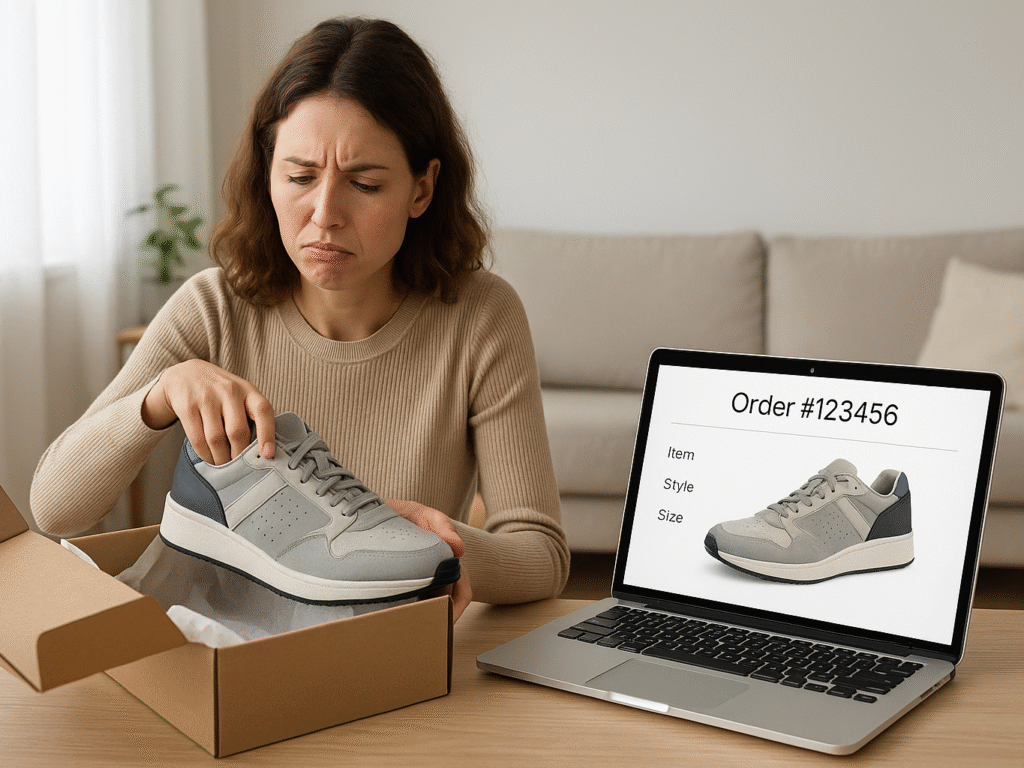
The return problem haunts e-commerce businesses worldwide, eating into profits and undermining customer satisfaction. Online purchases face a staggering 30% return rate, over three times higher than the 8.89% rate for brick-and-mortar stores. This dramatic difference stems primarily from one fundamental issue: customers can’t physically interact with products before buying.
1. Why Unmet Visual Expectations Cause Returns
The math is simple: when products arrive looking different from what was expected, they go back. At least 22% of online shoppers explicitly state they return items because they looked different from the images displayed in online stores. Traditional 2D product images fail to communicate true value or provide customers with the detailed understanding needed to make confident purchases.
Static images show only limited angles, creating information gaps about size, texture, and functionality. Furthermore, typical product photos often use manipulated lighting or editing to enhance appeal, further widening the gap between what customers see online and what arrives at their door. This visual disconnect becomes the primary driver of costly returns.
2. How E-commerce Product Visualization Services Solve This
E-commerce product visualization services tackle this problem head-on by providing customers with an interactive, comprehensive view of products before purchase. Unlike static images, 3D models allow shoppers to:
- Rotate products 360 degrees to examine from all angles
- Zoom in on tiny details and textures
- See inside parts that photos can’t show
- Interact with customizable features
- Visualize products in their own space through AR
This interactivity empowers customers to thoroughly examine products from every perspective, subsequently reducing uncertainty and minimizing return incidents caused by unmet expectations. For products requiring assembly or with moving parts, 3D animations demonstrate functionality, removing another common reason for returns.
Professional e-commerce product visualization services understand the psychology behind customer decision-making and create 3D experiences that address specific pain points. When customers can virtually “touch” and examine products, they develop realistic expectations that align with the actual product they’ll receive.
3. Before-and-After Return Rate Comparison
The numbers tell a compelling story about how ecommerce product visualization services impact returns:
Shopify users implementing 3D visualization have witnessed a remarkable 40% drop in return rates. Another study indicates a 5% decrease in returns for companies using professional 3D product visualization services. Home Depot reported a 35% reduction in product returns after implementing 3D viewing capabilities.
For online fashion retailers, where fit and appearance are crucial, 3D models with virtual try-on features can reduce returns by 25-35%. These reductions translate directly to cost savings and improved customer satisfaction. By eliminating the surprise factor and setting accurate expectations, quality ecommerce product visualization services ensure that what customers see is precisely what they get.
The key lies in working with experienced providers who understand both the technical requirements and the psychology of the customer. Many brands are discovering that the decision between 3D animation vs product photography delivers ROI not just through increased conversions, but through dramatically reduced return processing costs.
3D Animation vs Product Photography: When to Invest (Cost/ROI Analysis): Wondering whether to upgrade your product photography or invest in 3D animation? Our cost-benefit analysis shows exactly when each approach delivers maximum ROI. Stop guessing and start making data-driven decisions.
The Psychology Behind 3D Animations in E-Commerce
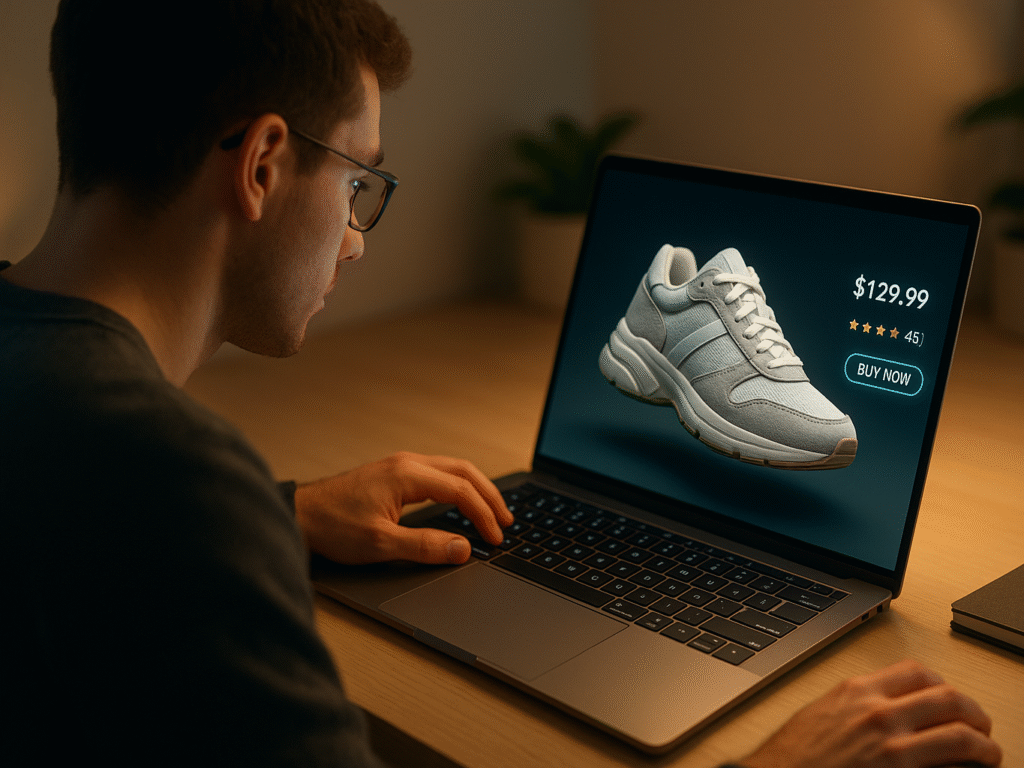
Behind the impressive conversion rates of 3D product animation for e-commerce lies a fascinating psychological foundation. The human brain processes visual information differently when interacting with three-dimensional content, creating powerful effects that traditional static images cannot match.
1. How 3D Mimics In-Store Experiences
The fundamental challenge of e-commerce has always been the inability to physically interact with products before purchasing. 3D product animation for e-commerce directly addresses this gap by recreating the tactile and immersive experience of physical shopping. As customers explore products from every conceivable angle, their brains process this information in ways remarkably similar to in-store browsing.
This technology enables customers to virtually place products within their environment using augmented reality, providing a more realistic representation than traditional methods. This capability mimics the crucial in-store experience of assessing how an item fits in your space or your Life.
Interestingly, this psychological alignment with physical shopping is so valuable that 40% of online shoppers are willing to pay more for 3D e-commerce experiences. As Farhan Thawar, VP of engineering at Shopify, explains: “Life is in 3D. That, to me, is the first part of spatial commerce.”
2. Visual Learning and Trust-Building
3D product animation for e-commerce substantially enhances customer confidence through comprehensive visual learning. This enhanced trust builds through several mechanisms:
- It builds trust by showing brands have “nothing to hide.”
- It sets accurate expectations, reducing buyer’s remorse
- It addresses uncertainty about product appearance, fit, and function
- It allows customers to discover product features they might otherwise miss
High-quality 3D renderings enable customers to examine products with incredible detail, mimicking the trust-building process that happens naturally in physical stores. Over two-thirds of shoppers report that interactive product images increase their confidence in a purchase.
3. Emotional Connection Through Interaction
The most powerful aspect of 3D visualization might be its ability to forge emotional bonds. Interactive 3D visuals create a sense of ownership before purchase, and customers become active participants rather than passive observers. This emotional engagement is what transforms browsers into buyers.
Customization features are particularly effective at driving conversions. Being able to personalize colors, materials, or configurations gives customers creative control and deeper personal investment in the product. This emotional connection is precisely what drives the transition from browsing to buying.
As a result, brands using 3D product animation for e-commerce see conversion rate increases of up to 250% because shoppers feel more confident, more engaged, and more emotionally connected to products they can virtually experience.
AI 3D Product Animation: Revolution or Hype? (Real Client Results): AI-powered 3D animation promises faster, cheaper results. But does it deliver? Our analysis of real client results reveals the truth about AI versus traditional methods. See the actual performance data before you invest.
Choosing the Right 3D Animation Service
Selecting the appropriate e-commerce product visualization services can make or break your 3D implementation success. With numerous options available, understanding what to look for ensures you invest in solutions that deliver measurable results.
1. What to Look for in a Provider
Rendering Quality and Realism The cornerstone of effective e-commerce product visualization services is photorealistic rendering quality. Look for providers who can demonstrate:
- High-resolution textures and materials
- Accurate lighting and shadows
- Smooth animations without lag
- Consistent quality across different devices
(i) Platform Compatibility
Your chosen service must seamlessly integrate with your e-commerce platform. Essential compatibility features include:
- Native Shopify and Amazon integration
- Mobile optimization for AR experiences
- Fast loading times across all devices
- Support for multiple file formats (glTF, USDZ, etc.)
(ii) Speed and Performance
Website performance directly impacts conversion rates. Quality e-commerce product visualization services should provide:
- Optimized file sizes without quality loss
- CDN delivery for global audiences
- Lazy loading capabilities
- Minimal impact on page load speeds
2. Recommended Tools and Services
(i) Professional Service Provider CGTrader
offers comprehensive 3D modeling services with e-commerce specialization. Their team creates custom 3D models optimized for online retail, with pricing starting at $150 per model.
(ii) Threekit
provides enterprise-level 3D visualization with advanced customization features. They specialize in complex products requiring configuration options and real-time rendering.
(iii) VNTANA
focuses specifically on fashion and apparel, offering 3D clothing visualization with virtual try-on capabilities. Their platform integrates directly with major e-commerce platforms.
(iv) All-in-One Solutions Zakeke
combines 2D, 3D, and AR product visualization in one platform. Starting at $39/month, it offers good value for small to medium-sized businesses.
(v) Angle 3D Configurator
specializes in customizable products, allowing customers to modify colors, materials, and configurations in real-time.
When evaluating options, consider your specific needs, budget, and technical requirements. Many businesses find success by starting with simpler solutions and scaling up as they see results. The rise of AI 3D product animation solutions offers new possibilities for cost-effective implementation, though the key is choosing services that align with your business goals and technical capabilities.
3. Cost-Effectiveness and ROI Considerations
Smart businesses evaluate e-commerce product visualization services based on total ROI rather than just upfront costs. Consider these factors:
(i) Initial Investment vs. Long-term Benefits
While quality 3D visualization requires upfront investment, the long-term benefits often justify the cost:
- Reduced return rates (saving 20-40% on return processing)
- Increased conversion rates (typically 20-250% improvement)
- Enhanced customer satisfaction and repeat purchases
- Competitive advantage in crowded markets
(ii) Scalability and Future-Proofing
Choose services that can grow with your business. Look for providers offering:
- Bulk pricing for multiple products
- Template-based solutions for product families
- Regular updates and new features
- Integration with emerging technologies
The most successful implementations often involve a combination of professional services for hero products and scalable solutions for broader catalog coverage. This hybrid approach maximizes impact while effectively managing costs.
Future-Proof Your Store with 3D Product Animation.
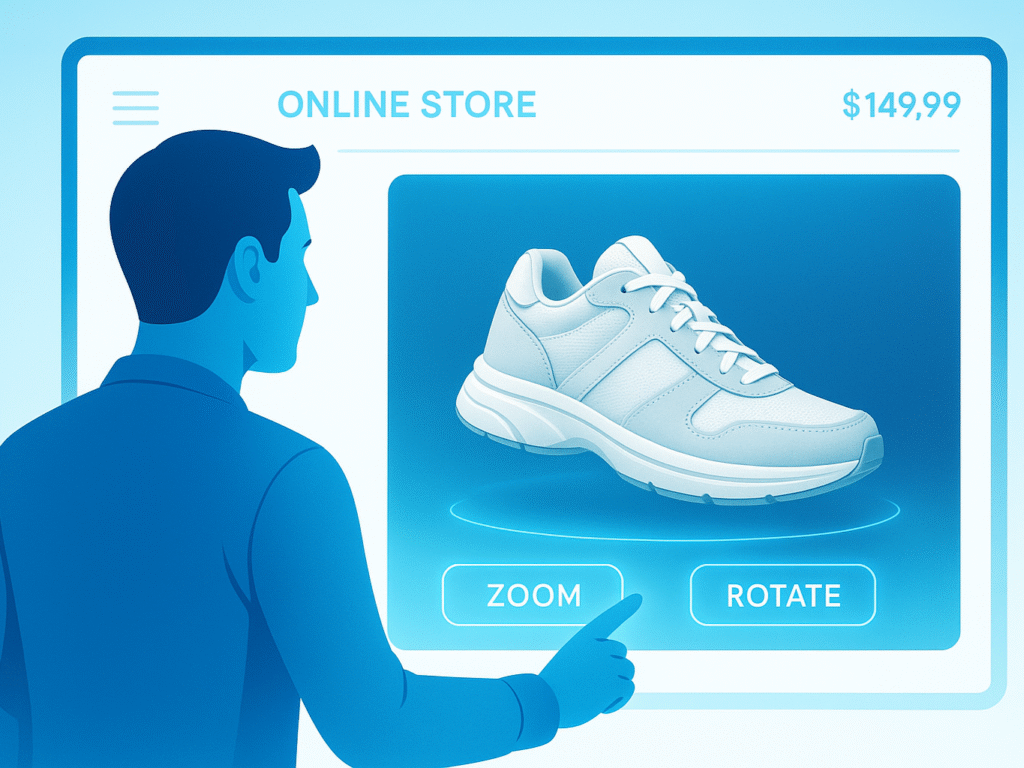
The e-commerce space is evolving fast. Shoppers expect more than static images; they want interaction. Customers now explore products by zooming, rotating, and viewing them from every angle. This shift in expectation is pushing brands to adopt more immersive product displays that improve buyer confidence and reduce hesitation.
Retailers adopting 3D product animation for e-commerce have seen conversion rates soar up to 250% and return rates drop by 30–40%. These numbers demonstrate that it’s not a gimmick, but a powerful tool that enhances the user experience. Buyers understand what they’re getting, so they buy faster and return less.
High-quality product interaction builds an emotional connection. When users can explore a product virtually, they feel more confident in their decision. This interaction mimics the in-store experience, leading to stronger brand loyalty. Engagement increases, and that means more checkouts, fewer abandoned carts, and happier customers overall.
Future-ready stores are already embracing 3D product animation for e-commerce on platforms like Shopify and Amazon. It’s transforming online shops into fully interactive experiences. If you’re aiming for fewer returns, better conversions, and higher customer satisfaction, now is the time to adopt and stand out from your competition.
FAQs on 3d product animation for e-commerce
Q1. What benefits do 3D product animations offer for e-commerce?
3D product animations create realistic, interactive shopping experiences that increase engagement and boost conversion rates. They help customers better understand product features, build trust, reduce returns, and drive more confident purchases, directly improving e-commerce performance and satisfaction.
Q2. How do 3D product animations affect customer interactions?
Shoppers interacting with 3D models spend more time on product pages, feel more connected, and are more likely to purchase. This digital interaction mimics physical shopping, making products feel tangible and leading to higher engagement and sales conversions.
Q3. What impact do 3D product animations have on return rates?
By providing accurate visualizations of size, design, and functionality, 3D animations reduce misunderstandings and boost confidence. This results in significantly fewer returns, saving sellers money while enhancing customer satisfaction and fostering long-term trust in the shopping experience.
Q4. How can you implement 3D animations on a Shopify product page?
Shopify supports 3D product animation for e-commerce using built-in features or third-party tools like VNTANA. You can upload compatible models and connect them to product listings, enabling AR and interactive viewing without needing coding or advanced development.
